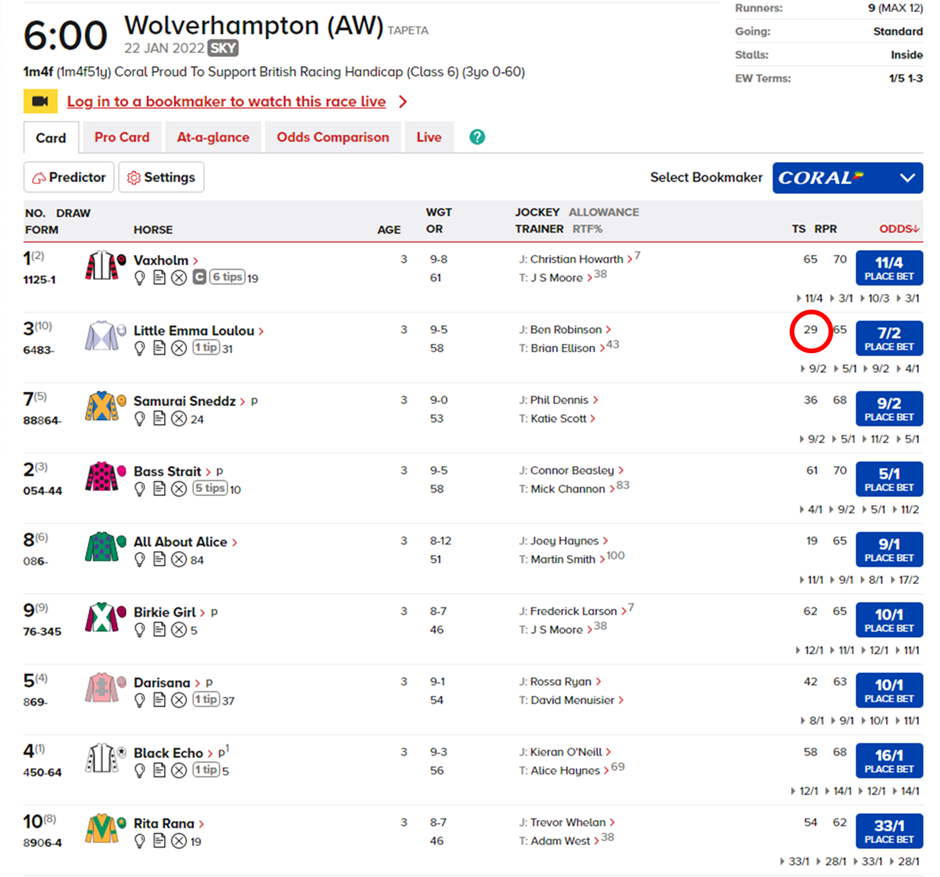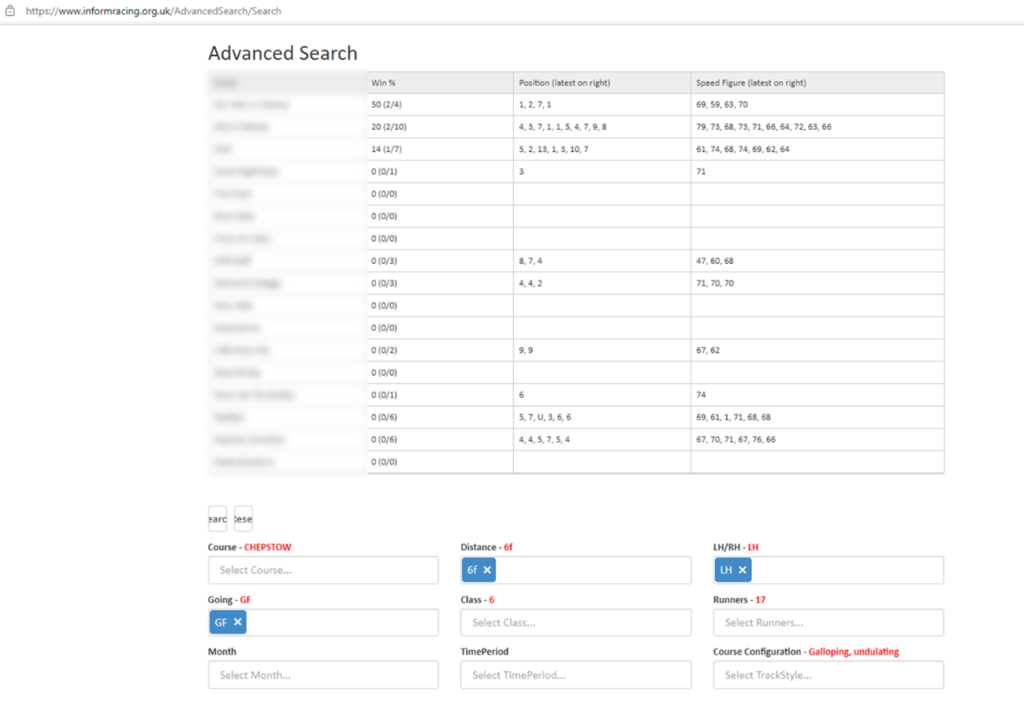The Racing Post’s top speed (TS) ratings are fully explained in this article. I also compare the use of the Racing Post’s TS ratings with Inform Racing’s speed ratings.
Speed is one of the most important factors for determining a horse’s chance of winning a race. Whether you are a punter or a trader, you should be interested in a horse’s winning chances. It is obvious that punters and in-play traders need to be aware of a horse’s winning chances.
For pre-race traders, the reason for being aware of a horse’s winning chances may be less obvious. An example of using speed ratings for pre-race trading, is when you notice a market move on an outsider. If the horse has a high speed rating, this move could be genuine. Therefore, understanding a horse’s winning chances can help you to decide whether to join in on the move.
So, let’s start by understanding how the Racing Post’s TS ratings are calculated.
A. The Racing Post’s Top Speed (TS) Ratings
There are 2 types of TS ratings in the Racing Post. The first are the adjusted TS ratings that you see on the race cards. The second are the raw TS ratings that you see in the horses’ history.
1. The Adjusted TS is the TS You See on the Race Cards
On the Racing Post’s race cards (as in Figures 1 and 3 later in the article), the TS is adjusted for the weight that the horse is due to carry in the current race. This adjusted speed rating is based on the horses’ best speed rating over the past year.
a) The Adjusted TS Rating is Restricted to the Racing Surface and Obstacles
Separate adjusted ratings are used for turf and all weather (AW) surfaces. Therefore, raw speed ratings on turf are only used to calculate adjusted speed ratings on turf. Similarly, raw speed ratings on AW surfaces are only used to calculate adjusted speed ratings on AW surfaces.
The same idea applies to obstacles. Raw speed ratings over hurdles are only used to calculate adjusted speed ratings over hurdles. Similarly, raw speed ratings over fences are only used to calculate adjusted speed ratings over fences.
b) Adjustments Made by the Racing Post’s TS Handicapper
In addition to adjusting the TS for weight, the Racing Post’s TS handicapper may tweak the adjusted TS rating for the current race’s conditions (eg the going) and the horse’s potential for improvement.
2. The Raw TS is the TS that You See in the Horse’s Race History
When you look at the horse’s history (as in Figures 2 and 4 later in the article), you will see the raw speed ratings. On the race cards, you will see adjusted speed ratings.
The Racing Post’s raw TS is adjusted to 12 stone in National Hunt races and to 10 stone on the Flat. The adjusted speed ratings (on the race cards) are adjusted in line with the weight that the horse is carrying in its current race.
3. How to Convert the Raw TS into the Adjusted TS
To explain the difference between the raw TS and the adjusted TS, I will give 2 examples of how to adjust a raw TS into an adjusted TS. The first will be a National Hunt race, while the second will be a flat race.
a) Example 1: National Hunt Racing – Raw TS is Adjusted to 12 stone
Figure 1 (below) shows a hurdle race. I will use the second favourite, Twilight Twist as an example. On the race card, the horse’s TS rating is 78. This is circled in red. The TS rating of 78 is adjusted to the weight that Twilight Twist is set to carry in the current race.
Figure 1: The Racing Post Race Cards: Adjusted TS Ratings for the Current Race (Retrieved from https://www.racingpost.com/racecards/2/ascot/2022-01-22/801335)

Let’s figure out how that rating was calculated.
STEP 1: FIND THE RAW RATINGS
If you click on the Twilight Twist’s name you will get a pop-up, which shows details of the horse’s previous races (see Figure 2). The races are ordered with the most recent race at the top.
Figure 2: The Racing Post Top Speed (TS) Ratings: Raw TS Ratings

Over hurdles, Twilight Twist was awarded a best TS rating within the last twelve months of 68.
STEP 2: ADJUST THE SPEED RATING FOR THE HORSE’s WEIGHT IN THE CURRENT RACE
In National Hunt racing, the raw speed ratings are the past ratings that are adjusted to 12 stone.
The race card shows that the horse is due to carry 11st 4lbs in the current race (Figure 1).
This weight is 10lbs less than 12st.
Therefore, we add 10 to the horse’s best speed rating over the last twelve months.
The calculation is 68 + 10lbs.
This gives us an adjusted TS rating of 78, which the speed rating shown on the race card (Figure 1)
b) Example 2: Flat Racing – Raw TS Adjusted to 10 stone
Figure 3 (below) shows a flat race on an all-weather (AW) surface. In this example, I will use the second favourite, Little Emma Loulou.
Figure 3: The Racing Post Race Cards: Adjusted TS Ratings for the Current Race (Retrieved from https://www.racingpost.com/racecards/513/wolverhampton-aw/2022-01-22/801502)

On the race card, the horse’s TS rating is 29. This shown, with a red circle around it. The TS rating of 29 is adjusted to the weight that Little Emma Loulou is set to carry in the current race.
Let’s figure out how that rating was calculated.
STEP 1: FIND THE RAW RATINGS
Figure 4 shows Little Emma Loulou’s previous races.
Figure 4: The Racing Post Top Speed (TS) Ratings: Raw TS Ratings

The TS ratings in Figure 4 are raw ratings that are adjusted to 10 stone.
I have put a red circle around the raw TS rating of 20, which is the rating that we are going to use for our calculation.
You will notice that there is a higher speed rating of 29 (circled in blue in Figure 4). I have ignored this rating because this speed rating was obtained over turf. The current race is over an AW surface. As mentioned earlier, the Racing Post uses separate adjusted ratings for turf and AW surfaces.
STEP 2: ADJUST THE SPEED RATING FOR THE HORSE’s WEIGHT IN THE CURRENT RACE
On the flat, the raw speed ratings are the past ratings that are adjusted to 10 stone.
The race card shows that the horse is due to carry 9st 5lbs in the current race (Figure 3).
This weight is 9lbs less than 10st.
Therefore, we add 9 to the horse’s best speed rating over the last twelve months.
The calculation is 20 + 9lbs.
This gives us an adjusted TS rating of 29, which the speed rating shown on the race card (Figure 3)
4. Problems With Using the Racing Post’s Speed Ratings
I like the Racing Post and I bought this newspaper for many years as a punter. I still use the online version for my form reading.
However, for the serious form-reader, there are several problems with the TS ratings.
a) We Often Want to Look at Recent Form
A year is a very long time in horse racing. The adjusted TS is based on the best speed rating over the past year. If you are reading form, you often want to assess a horse race, based on recent form. This is especially the case for favourites.
Old form can be of interest for outsiders. For example, if you see an outsider getting heavily backed and you notice that the horse has a high adjusted TS, this suggests that stable connections believe that their horse is back to its best form.
b) It is Time-Consuming to Compare Horses for Different Goings
Although the Racing Post’s TS handicapper may tweak the adjusted TS rating for the going, we usually want to consider the effect of the going separately from speed ratings.
As a punter, if a horse has not raced or has always performed poorly on the on the going, I would not consider betting on it. Therefore, it is of more value to me, for a speed rating to reflect the horse’s best performance on the going.
We can go through the raw speed ratings and convert them to adjusted speed ratings ourselves. Although the maths involved is simple, this is a time-consuming process.
c) Horses have Different Speed Ratings for Different Course Directions
Racecourses can be right-handed or left-handed. Many horses’ speed ratings are dependent on the direction of the racetrack. As such, a horse might run faster on a left-handed course, relative to a right-handed course and vice versa.
Comparing horses’ speed ratings over a course direction, would be a long process. You would need to determine the direction of each course that the horse has run on in the past. In the Racing Post, you can do this by clicking on the course and then on “course map”.
d) Different Distances are Not Taken into Account for the Adjusted Speed Ratings
The adjusted speed rating is based on the top speed rating over the past year, regardless of distance. Ideally, we would just like to see speed ratings, that are related to the distance, of the horse’s current race.
B. Inform Racing Speed Ratings
In general, it is a long process to compare horses’ speed ratings by using the Racing Post. The solution to all of the difficulties, outlined above is to use Inform Racing’s speed ratings.
Inform Racing have been online since 2003. Although Inform Racing does cost money, it is a huge time-saver.
1. Inform Racing Race Cards
Inform Racing race cards allow you to see the speed ratings from the horse’s last 3 races at a glance. You can also see whether the horse is racing in a higher or lower class, compared to its previous race. In addition, you can see the draw, run style, and the amount of weight that a horse has gone up or down in the weights.
Figure 5 shows that these race variables are conveniently organised on the Inform Racing race cards.
Figure 5: Screenshot of an Inform Racing Race Card

Click Here to Go to Inform Racing
Affiliate Disclosure: I am an affiliate of Inform Racing. Therefore, if you buy Inform Racing through my affiliate link, I get a commission.
The horse’s names have been blurred for this article. On the race cards, you can see the speed ratings for the horse’s last 3 races. When you mouse over a speed rating, a pop-up appears that shows details of the race conditions (eg going, distance, class, jockey, the position the horse came in at, the number of runners in the race and the starting price) of the race that the speed rating was obtained in.
You can see more of the horse’s past speed ratings of you click on advanced search link.
2. The Advanced Search Feature
Inform Racing also has an Advanced Search Feature, which is shown in Figure 6. This feature allows you to filter out irrelevant race conditions. For example, you might not be interested in speed ratings on firm ground, if the current race is on soft ground.
The Inform Racing Advanced Search Feature allows you to input race variables in any combination and obtain speed ratings of all the horses just for the race conditions that you have chosen.
Figure 6: Screenshot of an Inform Racing’s Advanced Search Calculator

Click Here to Go to Inform Racing
Affiliate Disclosure: I am an affiliate of Inform Racing. Therefore, if you buy Inform Racing through my affiliate link, I get a commission.
The variables include course, distance, course direction, going, class, course configuration, race type (eg hurdle/chase/turf/AW) and more. You can input these variables either individually or combined.
In the example in Figure 6, I have looked up the speed ratings on good-firm going, over 6 furlongs and on a left-handed course.
C. Conclusions
Inform Racing is not expensive if you work out the cost per day. However, it saves an incredible amount of time. It takes just a few seconds to pull out the speed ratings for the relevant race conditions. In addition, you can see all of the speed ratings of the horses in the race on one screen.
